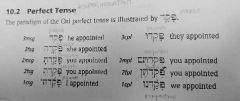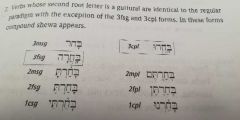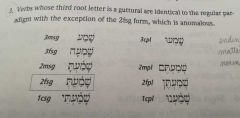![]()
![]()
![]()
Use LEFT and RIGHT arrow keys to navigate between flashcards;
Use UP and DOWN arrow keys to flip the card;
H to show hint;
A reads text to speech;
42 Cards in this Set
- Front
- Back
- 3rd side (hint)
|
Sibilants are... |
Zayin Samek Sin Tsade |
There are 4 in total. |
|
|
Gutturals are... |
Aleph Hey Ayin Het Resh |
There are 5 in total. |
|
|
BeGadKePhat |
With dagesh = hard consonants Without dagesh = soft
Bet/vet Gimmel Kaf/khaf Pey/fey Tav |
|
|
|
Summary of vowels |

|
|
|
|
Length of vowels |

|
|
|
|
Two types of syllables |
Open: Cv Closed: CvC Accent usually on last syllable, unless otherwise indicated |
|
|
|
Shewa under the first letter of a syllable is _________. |
Vocal.
|
|
|
|
Shewa under a letter that closes a syllable is ________. |
Silent. |
|
|
|
When a letter with shewa follows a long vowel, shewa is ________ and the letter with the shewa is a new syllable. |
Vocal |
|
|
|
When a letter with shewa follows a short vowel, shewa is _______and closes the syllable. |
Silent. |
|
|
|
When two shewas occur together under 2 consecutive letters within a word, the first is ______ and the second is _____. |
Silent, vocal |
|
|
|
Compound shewas and gutturals |
If hatep vowels: vocal. If simple shewa: silent. |
|
|
|
Two shewas are not written consecutively at the beginning of a word. Rather, the first becomes _____. |
Hireq |
|
|
|
When the second of the 2 shewas is compound shewa, the first shewa __________________________________________________________. |
changes to the full short vowel that corresponds to the following compound shewa. |
|
|
|
T plus closed and unaccented = |
Qames-hatup |
|
|
|
T plus meteg and closed & accented = |
Qames |
|
|
|
Dages lene |
Begadkephat Hard letters when no vowel sound immediate precedes the letter. |
|
|
|
Dages forte |
Appears in any letter except the guttarals and resh to indicate doubling. Can appear in begadkephat letters (if preceding is vowel, then it is dages forte) |
|
|
|
Mappiq |
Dot in the consonant hey at the end of the word |
|
|
|
Quiescent Letters |

Exception to the CvC/Cv rule. Segol lengthens to sere Yod at the beginning of the word may merge with the secondary hireq of a prefixed element such as Le Example: le + Yehuda = lihuda |
|
|
|
Article before weak letters |
Ha + word = doubling the first letter or the word, but dages forte can't be added to guttural letters.
In words beginning with hard gutturals hey and het, implied doubling (no dages forte, vowel under article remains patah)
In words beginning with Yod + shewa and Mem + shewa, dages forte is omitted and vowel remains patah. Shewa under these letters form a closed syllable with the short vowel of the article, and doubling is omitted. Example: yeled (children), ha'yeled (the children)
Compensatory lengthening = patah lengthens to qames before aleph, ayin, and resh
The vowel under the article changes to segol if the word begins with: 1) unaccented ha (hey plus qames) 2) unaccented 'a (Ayin plus qames) 3) unaccented ha or accented ha (chet plus qames) 4) unaccented ho (chet plus hatep qames) |
|
|
|
Sus Paradigm |

|
|
|
|
Coordinating conjunction |
Vav = and, but, now 1. Never replaces hey of the article. 2. Takes simple vocal shewa 3. Before a word beginning with a guttural and compound shewa, the conjunction takes corresponding short vowel. 4. Before a word beginning with [Yod + shewa], vav takes hireq and Yod becomes quiescent. 5. Before a consonant with a simple shewa, vav becomes shurreq. 6. Before BMP, the conjunction is also shurreq. |
|
|
|
Propretonic reductions in nouns |
Qames and sere regularly reduce to shewa in a open propretonic syllable. |
|
|
|
Pretonic reduction in nouns |
Pretonic sere does reduce when suffix is added (because stress on the word has changed). |
|
|
|
Segholate nouns |
When pluralized: Segol/patah = vocal shewa and qames. |
|
|
|
Min- |
Min = from; may be written separately or with maqqep
Before non-guttural letter: the n of the preposition disappears and leaves dages forte or turns into hireq yod.
Before guttural letters: short hireq becomes long sere and no n |
|
|
|
Adjectives function as... |
Attributives, predicates, and substantives. |
|
|
|
Attributive adjective |
Modifies a noun.
Threefold agreement: gender/#/definiteness |
|
|
|
Predicative adjective |
Noun is subject, adjective is predicate. Predicative adjective precedes the noun. Two-fold agreement: Gender/# Adjective will be indefinite. |
|
|
|
Substantive adjective |
Function in the place of nouns Always definite No agreement because there is no noun to agree with (implied noun) |
|
|
|
Comparisons using min |
1. Thing being discussed is simple noun. 2. Noun with min is the one which noun #1 is compared to. 3. Min is translated as "than" 4. Min is translated in comparative degree. |
|
|

|
Paqad: he appointed Paqedah: she appointed Paqadta: you (msg) appointed Paqadt: you (fsg) appointed Paqadti: I appointed Paqadu: they appointed Paqadtem: you (mpl) appointed Paqadten: you (fpl) appointed Paqadnu: we appointed |
|
|
|
Verbs whose first root letter is a guttural are identical to the regular paradigm with the exception of... |

2mpl and 2fpl
Instead of vocal shewa, compound shewa is present. |
|
|
|
Verbs whose second root letter is a guttural are identical to the regular paradigm with the exception of... |

3fsg and 3cpl
Compound shewa appears. |
|
|
|
Verbs whose third root letter is a guttural are identical to the regular paradigm with the exception of... |

2fsg, which is anomalous. |
|
|
|
Sign of the accusative |
Et is written before the direct object of a verb whenever that object is a definite noun. |
|
|

|
Independent personal pronouns He = hu She = hi You (ms) = ata You (fs) = at I = Ani or anoki They (mpl) = hema or hem They (fpl) = hen/hena You (mpl) = atem You (fpl) = aten/atenah We = anahnu |
|
|
|
This and these |

May take the definite article Msg = zeh and hazeh Fsg = zot and hazot Cpl = eleh and ha'eleh |
|
|
|
That and those |

Msg = hu and hahu Fsg = hi and hahi Mpl = hema or hem, hahemah or hahem Fpl = henah or hahenah |
|
|
|
Demonstrative function as either pronouns or adjectives. |
Pronoun will not have article but will have two-fold agreement: # and gender. Adjective: Three-fold agreement (#/gender/definiteness) |
|
|
|
Construct noun endings |

|
|

